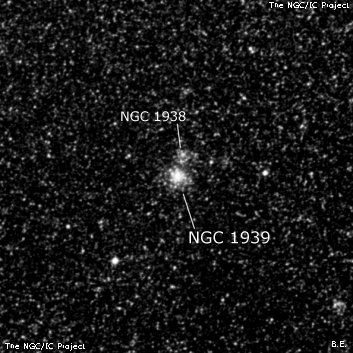
James Dunlop probably discovered NGC 1939 = D 89 on 24 Sep 1826 and described a "pretty well-defined round nebula, about 20" diameter." His position is ~5' NE of NGC 1938 and 1939, a close pair of clusters. Perhaps he noticed the combined glow of both clusters (though the size would then be too small), or he only picked up NGC 1939, which is the brighter cluster. See Corwin's notes for more on the clusters.
JH observed the pair of clusters NGC 1938/1939 = h2848) on 24 Nov 1834 and described a "B; R; a double nebula (clouding over)." On a second observation he recorded "pB; S; R; glbM; a double nebula. It has a vF neb attached np." On a third sweep he logged "A double neb. Pos 339.1; 50" dist; each F; R; glbM; 35" and 30". He attributed Dunlop with the discovery.
600/800mm - 30" (10/18/17 - OzSky): at 264x and 429x; bright, fairly small, round, 40" diameter, high surface brightness with an intensely bright nucleus. Brighter of a close pair with NGC 1938 only 0.8' N. NGC 1939 is one of 15 bona-fide ancient GC's in the LMC. A mag 10.7 star is 3' SE.
While looking for this cluster I picked up an unplotted cluster, Hodge-Sexton 253, situated 6.6' SE of NGC 1939 and 3.7' SE of the mag 10.7 star. It appeared moderately bright, round, ~35" diameter, no significant concentration. S-L 412, situated 7' N of NGC 1939, was a roundish, fairly faint glow, ~24" diameter. In addtion, LMC-N127A lies 16' N of NGC 1939. At 264x this emission nebula was bright, compact, roundish, 40" diameter, with a star visible at the center. Very good response to the NPB (narrow-band) filter with a slightly brighter central region and thin fainter halo.. It forms a "pair" with open cluster S-L 418 2' NE.
30" (10/15/15 - OzSky): at 303x; bright, fairly small, round, 45" diameter, high surface brightness, mottled, contains a very bright core. Forms a close pair with NGC 1938 just 0.8' NNW. A mag 10.7 star lies 2.9' SE. NGC 1943 lies 14' SSE and NGC 1950 is 16' ENE.
Notes by Steve Gottlieb